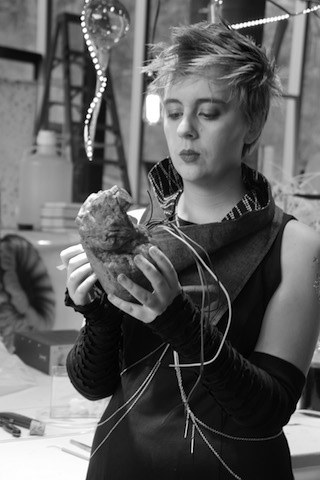Frankenstein 2029 is a bold, challenging experiment that succeeds more often than not
“Frankenstein 2029” is a bold experiment in theatrical presentation that, though confusing, chaotic and a bit disjointed, delivers a fascinating and rewarding experience—if, that is, you’ve done your homework.
The play, written by Gavin Knox ’17 and Professor of Theater Suzanne Westfall, tells three stories simultaneously: that of Victor Frankenstein in 2029, Victor Frankenstein from the book and Mary Shelly as she writes “Frankenstein.” It has less of a plot line and more of a plot grenade—the story goes in all directions at once with little forewarning. It is an incredibly confusing affair that will likely leave behind those who have never taken a college-level class about the book. The play is grounded heavily in an academic interpretation of “Frankenstein,” so many of the themes and ideas are extremely easy to miss, and few scenes will make any kind of sense unless you have some idea what they are paralleling or retelling.
All of that is assuming you don’t miss the important scenes entirely, which is extremely possible. “Frankenstein 2029” uses every building on the arts campus. You are allowed and encouraged to walk to each of the eight settings, where actors perform scenes simultaneously, even if no audience members are present.
Consequently, no two audience members will have the same experience. But this leads to confusing and frustrating situations. Both in the program and when you buy a ticket, the organizers emphasize that the stage play that begins at 9:30 and continues throughout the entire show. I was under the impression that this play was the main scene, so spent more time there than any other area. While seeing this play-within-a-play, however, I missed the monster was escaping from the laboratory simply because I was unaware of the scene’s existence. I didn’t even see the 2029 monster until the last third of the play because I had no idea where he was. Scenes are going on all over the place and most are inconsequential. But there is no way to tell when and where the important scenes are for those few that are essential.
There are almost no opportunities to comfortably sit, even in the theater, so potential guests who have trouble standing for long periods are best served not going. Potential guests with limited mobility should be advised that it can be quite difficult to dash between settings to follow a single subplot, and they are best advised to stick to the theater where the lion’s share of the story takes place.
All of these factors mar a monumental achievement on the behalf of the theater department. More than eighty people worked on the show, with dozens of actors maintaining character in all their interactions and doing an excellent job of it. Of particular note, both the Original Monster (Alex Meriman ‘16) and the 2029 Monster (Willem Ytsma ‘16) are brilliant, visibly developing as their intelligence increases. There were no bad performances that I saw, and all the actors fully committed to their roles even when they did not see any audience members around them.
Perhaps the most interesting part of the play is the costume design. The characters from the future look amazing and detailed. The dazzling lights, metal and science fiction aesthetic is something you need to see to believe. Characters from the past look and feel authentic, and all the sets look gorgeous and perfectly compliment the action. This is all with the exception of the scenes on the street. The characters from the past felt out of place in these and were the hardest to hear due to the noise of the traffic.
Knox and Westfall should be proud of their writing. It managed to tie all the plots together and keep the characters feeling distinct and full of personality. There were almost no bad lines, and I sincerely wish the acoustics of the play were better so I didn’t miss a word. The pacing felt disjointed to me, but due to the nature of the presentation it will feel different for each audience member. I hope they write in this style again, so they can improve the pacing of such a chaotic format.
“Frankenstein 2029” is best enjoyed with multiple viewings to get a variety of experiences. I intend to attend another performance to see what I missed. Even if you don’t like it, it is like nothing you have ever experienced. The chaotic presentation and confusing plot make it inaccessible to those who have not studied “Frankenstein,” and the awful decision to have scenes on the street and in certain areas make it hard on both the performers and the audience. But the good far outweighs the bad. It is a worthwhile experience, and I sincerely hope the Theater Department tries this format again in the future.





















































































































![Scenes from Lafayette’s Frankenstein 2029 production, which runs through this Saturday, depict three stories: the story of old Frankenstein, new Frankenstein and Mary Shelley as she writes her masterpiece. This play is a Lafayette original, written by Gavin Knox ‘17 and theater professor Suzanne Westfall. [Photos by Hana Isihara '17]](https://lafayettestudentnews.com/wp-content/uploads/2015/04/img_70651.jpg)

ed kerns • Apr 24, 2015 at 11:26 pm
the art department had a little something to do with the production of this performance. as well ..look in to it…..